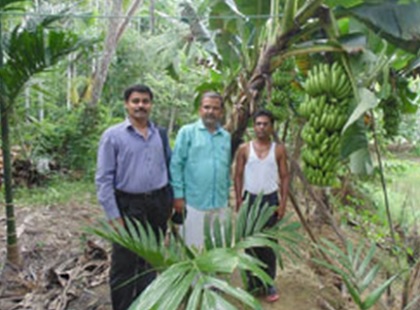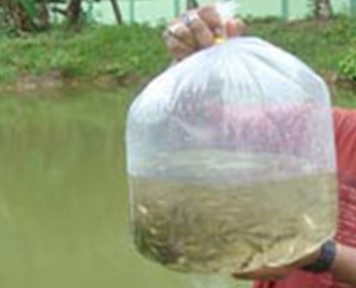Technology Enables Farmers to Secure Livelihood in Andaman Islands
The Climate of coastal lowlands of Andaman Islands is not conducive for agriculture due to various environmental factors. Fewer rainy days, increasing length of dry spell along with soil salinity during dry season makes agriculture highly vulnerable in this area. It is vital to manage the threat emanating from the rising mean global temperature and sea level to ensure the sustainable livelihood of people inhabiting these areas. In addition, after 2004, tsunami seawater is more often gushing into the land inundating paddy fields with saline water. Inundation by seawater combined with heavy tropical rain often destroy field crop. Collinpur village of South Andaman is one among the several villages affected by these problems.
Realising that agriculture and livelihood are being worst affected by saline water intrusion and climate change a raised bed and furrow system was demonstrated in the field of Shri. Ranjit Baroi and ten other farmers at Collinpur Village, South Andaman Island by ICAR-Central Island Agricultural Research Institute, Port Blair under National Agricultural Innovation Project. Since then, life has dramatically changed for Shri Baroi of Collinpur village, South Andaman Island in a span of three years from 2012.
The raised bed and furrow (RBF) system comprised of three raised beds of 4 m width and equal number of furrows of 6 m width formed to a convenient length (~ 36 m) in an area of about 0.3 acre of coastal lowland made in March 2013. The salts and the other toxic substances from the raised beds were leached out using rainwater during the subsequent rainy season. Rain water was harvested in the furrows from 2014 onwards after draining off the water harvested in the first year. By the end of July 2014 nearly 465 m3 of fresh water was harvested and stored in the three furrows which was good enough for culturing of Indian Major Carps. ICAR-CIARI provided fishlings and the farmer subsequently restored his backyard poultry farming of Vanaraja birds. Shri Baroi used regular agro-advisories received from the agromet unit of the Institute for planning and executing agricultural operations.
The farmer started cultivating banana in the beds of RBF system organically by using compost prepared from farm wastes and poultry manure and Panchagavya. The water from the furrows was used to irrigate banana crop during dry season and short duration vegetables such as amaranthus and radish grown as intercrop successfully harvested. Shri. Baroi succeeded in integrating fruits, vegetables, fish and poultry in his field by the technical support and knowledge gained from the Institute and earned Rs.40,000 from his 0.3 acre intervention and the income would increase in the coming years. He has become a model farmer to emulate in the rest of the coastal lowlands of Andaman Islands.
“My fortune came from ICAR-CIARI in the form of raised bed and furrow system and enabling technology for organic cultivation banana in the degraded coastal lowlands”, the farmer thankfully acknowledged.
This model can even sustain against the impacts of climate change in this remote part of the country.
(Source: ICAR-Central Island Agricultural Research Institute, Port Blair)



